Article and Photos by Joe Sapia

Turning over the vegetable garden
Author’s note: The yard references are to my house in the section of Monroe between Helmetta and Jamesburg in South Middlesex County. My yard is in a Pine Barrens outlier on the Inner Coastal Plain, the soil is loamy, and my neighborhood is on the boundary of Gardening Zones 6b (cooler) and 7a (warmer).
MESSING UP PREPPING THE VEGETABLE GARDEN: To get a jump on the vegetable garden, I sowed inside early season plant seeds of lettuce, carrots, and peas. That was a mistake. When I was transitioning them to plant outside, I killed them. I should have waited and planted them directly into the garden. So, I had to regroup….
…PLANTING THE EARLY SEASON GARDEN: I bought new seeds – “Salad Bowl Green Heirloom Lettuce,” “Rainbow Blend Carrots,” and “Sugar Daddy Snap Peas,” all Lake Valley Seeds brand – and planted the early spring garden April 8.
NEXT UP AT THE GARDEN: I will plant the summer crops – sweet corn, tomatoes, cantaloupe, and cucumbers, along with zinnias for color and to attract pollinators – roughly May 20 (if the weather has been warm) to June 1 (if the weather has been cool).
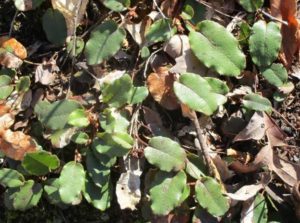
Unflowering trailing arbutus, or “May pink.”
FLOWERING IN THE WOODS: Swamp maples have their red tinge of buds, along with the budding of “May pinks” (trailing arbutus). I saw a report trailing arbutus has already flowered in the main Pine Barrens to the south, but have not seen any beyond budding in the Pine Barrens around Helmetta.
BIRDS SINGING SPRING SONGS: I am hearing the birds beginning their daily singing about 6 a.m. to 6:15 a.m., or about 15 to 40 minutes before sunrise. The birds presumably are singing to assert territory and to attract mates.
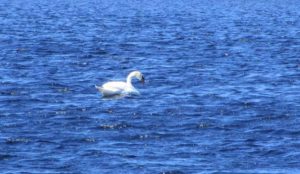
A beautiful, but invasive, mute swan at Helmetta Pond
“POND PIGS” AT HELMETTA POND: While beautiful, mute swans are a non-native bird that have been naturalized in America – and are disrupting the natural world around them. They are aggressive to humans and animals and deplete food supplies. There were brought to this country from Europe in the late 1800s and early 1900s.
LAST SNOW OF THE SEASON: Since the winter of 1995-1996, it has snowed as late as April 16 (April 9-10 for accumulating snow). Judging from the upcoming weather forecast, we probably had our last snow of the season, which was March 15.
OCCASIONAL LOUDNESS OF THE NEW JERSEY TURNPIKE: Wonder why the sound of the Turnpike is very loud at times, well beyond the quiet background noise? Probably because of warmer temperatures in the air compared with colder ones at the ground level.
GREEN WATERING OF THE GARDEN: Last year, I used a combination of drinking water from the house spigot and “gray” water (used bathing water). I got thinking about conserving house water – or even more conservation than I already do – and not putting soapy bath water into the garden. So, this year, 1. I am going to try using more accumulated rain water, making sure I keep the barrel covered when not in use so as not to promote mosquito breeding; 2. I am going to try to use available fresh water, perhaps from Manalapan Brook and a nearby swamp.; and 3., Conserve even more water at home. (In the 15 years since I have been taken over the family house, I have cut water usage by up to about 50 percent, the results of a bathroom renovation and conservation.
SUNRISE/SUNSET for April 2 to 8: Roughly about 6:20 to 6:30 Eastern Daylight Time for sunrise and about 7:30 to 7:35 for sunset.
VIEWING THE INTERNATIONAL SPACE STATION: The ISS may be visible Tuesday, April 11, 8:16 p.m. to 8:21 p.m., from north northwest to east; Friday, April 14, 8:53 p.m. to 8:56 p.m.; and Saturday, April 15, 8:02 p.m. to 8:06 p.m.
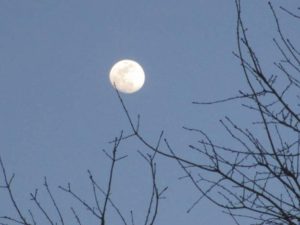
The near-full moon over Manalapan Brook in Monroe
NIGHT SKY: The Full Sprouting Grass Moon is on the Monday-Tueday, April 10-11, overnight. Also, see http://earthsky.org/tonight.
DROUGHT: With the recent rains, drought concerns may be lifted in the coming days by the state Department of Environmental Protection.
— Joseph Sapia
2017, April 9, Sunday,
Joe Sapia, 60, is a lifelong Monroe resident. He is a Pine Barrens naturalist and an organic vegetable-fruit gardener. He gardens the same backyard plot as did his Italian-American father, Joe Sr., and his Polish-immigrant, maternal grandmother, Annie Poznanski Onda. Both are inspirations for his food gardening. He draws inspiration on the local Pine Barrens from his mother, Sophie Onda Sapia, who lived her whole life in the local Pines, and his grandmother.
Article and photos by Joe Mish
RAINFALL: It rained about 2.5 inches in the New Brunswick-Trenton area at the end of last week. So, it will be interesting to see what this week’s drought maps say.
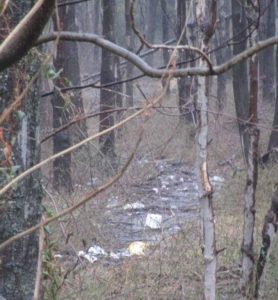
Garbage floating in a Monroe, Middlesex County, drainage ditch
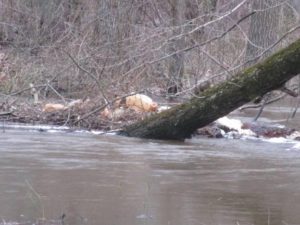
Garbage caught on a tree snag
in Manalapan Brook, Monroe, Middlesex County
NON-POINT SOURCE POLLUTION: During and after the week’s rains, the flow of non-point source pollution was obvious in our waterways. The cost-free way of dealing with it is, do not litter and do not leave stuff out in the yard, then it will not float into waterways.
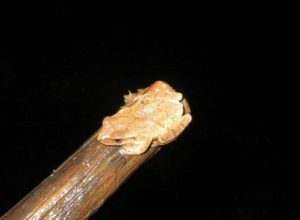
A spring peeper treefrog, found in the Manalapan Brook floodplain
FROGS: I walked into the swamp hardwood forest of the Manalapan Brook floodplain between Helmetta and Jamesburg early in the week. The sleigh bells-like sound of spring peeper treefrogs, “Pseudacris crucifer crucifer,” was obvious. I also heard monkey chattering-like sound of wood frogs, “Rana sylvatica.”
RASPBERRIES: I planted five bare-root Burpee seed company Caroline raspberry plants.
GARDEN ZONES: Depending on the source, the area is Garden Zone 6 (cooler) to Garden Zone 7 (warmer). That means our last frost generally is April 15 to 30; Our first frost is generally Oct. 11 to 20. Beyond that, I am playing it safe and sticking with Zone 6 for my Helmetta area, Middlesex County, home, although the area becoming a solid Zone 7 because of global warming is likely just around the corner.
OUTDOOR PLANTING FOR SUMMER VEGETABLES AND FRUITS: My rule of thumb is May 20 if it is a warm to normal and, if it is cooler, wait to June 1.
PREPARING PLANTS INDOOR: This year, though, I am trying something new, sowing plants indoors before the outside plant dates. So, I am experimenting with Kaleidoscope Blend Organic and Touchon carrots, Iceberg A lettuce, and Sugar Snap peas, all Burpee, which I began sowing about March 5. I added Rutgers tomatoes about March 25. I plan on sowing more tomatoes – Brandywine Red and Red Cherry, both Lake Valley brand – indoors in the next day or so.
HUMMINGBIRDS: Get the hummingbird feeders up by about April 15 to attract the early “scout” birds and they hopefully will lead later-arriving hummingbirds to the feeders.
NIGHT SKY: http://www.skyandtelescope.com/observing/sky-at-a-glance/this-weeks-sky-at-a-glance-march-31-april-8/.
SUNRISE/SUNSET: Approximate times are April 2, Sunday, 6:40 and 7:23 Eastern Daylight Time; April 3, Monday, 6:38 and 7:25; April 4, Tuesday, 6:36 and 7:26; April 5, Wednesday, 6:35 and 7:27; April 6, Thursday, 6:33 and 7:28[ April 7, Friday, 6:31 and 7:29; an April 8, Saturday, 6:30 and 7:30.
WEATHER: Local weather forecasts are available at http://www.weather.gov/phi/.

Carnegie Lake near the Kingston dam
on the boundary of Mercer, Middlesex, and Somerset counties
Joe Sapia, 60-years-old, grew up and lives in the Pine Barrens around Helmetta, where his family has resided for more than 100 years. He can be reached at Snufftin@aol.com or at P.O. Box 275, Helmetta, 08828.
Article and photos by Joseph Sapia
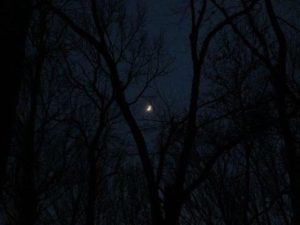
Above the Manalapan Brook floodplain, a crescent moon waxed toward December’s Full Long Nights Moon
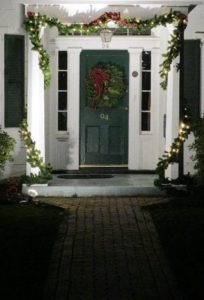
Christmastime in Fair Haven, Monmouth County
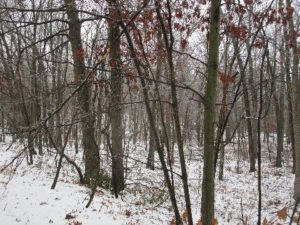
Snowfall of 1-1/2 inches December 17 in the Jamesburg Park Conservation Area, Middlesex County
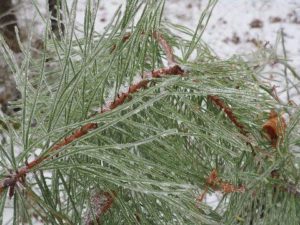
Ice builds up on the needles of a pitch pine, Pinus rigida, the common tree of the New Jersey Pine Barrens. Here, in the Jamesburg Park Conservation Area in the Pine Barrens around Helmetta.
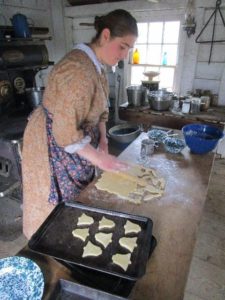
Christmastime at historic Longstreet Farm, the Monmouth County Park System’s living history farm, replicating the late 1800s in Holmdel. Here, baking cookies the old-fashioned way.
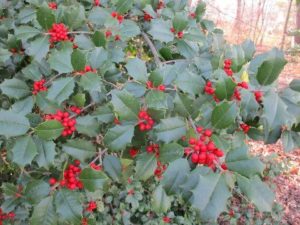
Holly in my neigbhorhood in Monroe, Middlesex County.
Joe Sapia, 60-years-old, grew up and lives in the Pine Barrens around Helmetta, where his family has resided for more than 100 years. He can be reached at Snufftin@aol.com or at P.O. Box 275, Helmetta, 08828.
Article and photos by Joseph Sapia

Shekiro’s Pond in Helmetta
Joey Slezak grew up in South Jersey, but he has multi-generational roots in the Pine Barrens around Helmetta and has lived in his parental grandparents’s former house in Helmetta while studying at Rutgers University in New Brunswick. In his own right, Joey is a meteorology student at Rutgers, an outdoorsman, and, importantly to me in the outdoors, my go-to science guy.
I was looking forward to walking afield with him – perhaps not on as cold a day as February 18, 2015. Minus 1 degree at dawn and 9 degrees when I left my house about two hours later. But between our schedules, we had to take advantage of this opportunity, cold or not. Plus, we are woodsmen from Helmetta of tough local Polish stock. So, we plunged into the approximately 15 degrees when we finally started walking before 10 a.m.
A woodpecker hammered away. A few inches of snow covered the ground – on the surface, it was fluffy — and clung to trees.
“You could see the snow fall from the trees, these little flakes go by,” said Joey, 22-years-old at the time and working on his bachelor’s degree in meteorology.
On this day, we would spend much time in wetlands, including an Atlantic white cedar swamp being threatened by invasive phragmites.
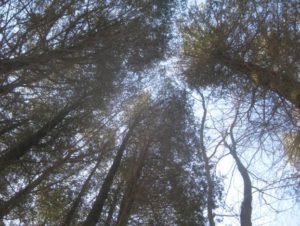
Looking skyward from the Atlantic white cedar swamp
“This is probably as secluded as you could be in these woods,” I said.
It was very quiet, until a jet airplane flew by.
“The final approach to Newark Airport comes over us,” Joey said.
Despite the cold, I was surprisingly warm.
“Once you heat up your clothes, there’s no wind to dissipate it,” Joey said. “(And) you’re dressed for it.”
I was dressed in long underwear, bottoms and tops; covered with a sweater and windbreaker jacket, all made of materials to wick sweat.
Joey pointed out hoar frost, a crystallized coating of frost. With the hoar frost, Mother Nature worked her art on any icy surface of water and on blades of vegetation.

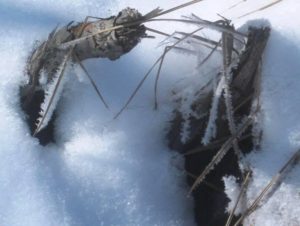
Mother Nature’s artwork: hoar frost.
Here and there, we were in danger of breaking through the swamp ice. I went up to my shins at one point, up to my thigh at another. Joey noted how he could smell the swamp when I broke through.
As we walked, we noticed evidence of the day’s low humidity – in the clarity and blueness of the sky.
“Not a cloud in the sky (hardly), a bluebird day,” said Joey, who, now in 2017, is working on his master’s degree in atmospheric science.
As we walked a sand road, we noticed fallen trees, lying northeast to southwest.
“That’s probably coastal,” Joey said, meaning a storm out of the east, rather than in the normal flow of wind from the west.
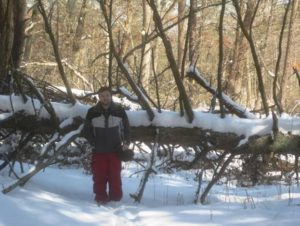
Joey Slezak at a treefall.
Perhaps the highlight of the day was hearing the call – a running-a-finger-along-the-teeth-of-a-comb sound — of a New Jersey chorus frog. This frog is an early caller, breeding as early as February, according to New Jersey Division of Fish and Wildlife literature.
“That sun’s getting warm,” Joey said.
By the time we ended the walk at lunchtime, the temperature was about 30.
“I had a lot of work to do, a lot of stress,” Joey said. “It felt pretty good to get out there.”
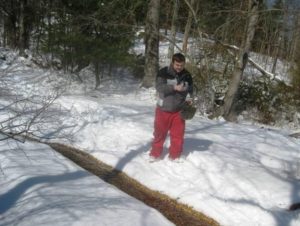
Joey Slezak at a small stream
Joe Sapia, 60-years-old, grew up and lives in the Pine Barrens around Helmetta, where his family has resided for more than 100 years. He can be reached at Snufftin@aol.com or at P.O. Box 275, Helmetta, 08828.
Photos and Article by Joseph Sapia
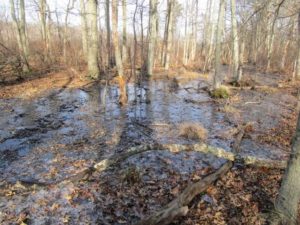
A pond at Szeliga’s Orchard
On this near-to-Christmas day, I was without my Jeep, which was in the shop for most of the day for routine, but time-consuming, maintenance. Without a vehicle, I was living life by foot – walking a mile or so to lunch at the old general store in Helmetta and picking up my mail from my third-generation Post Office box next-door. The walk was to be pragramtic, rather than playful, although I chose a route skirting the woods, instead of walking the Main Road directly from my neighborhood.
After 60 years of living and about 40 years as a journalist, I should know, Be ready for what is out there, unexpected or not. As a woodsman here in the Pine Barrens around Helmetta since old enough, I should know, A walk is not simply a walk.
So, I was glad I put my camera in my pocket.
Before I even left the neighborhood, I came upon a cluster of holly, thick with leaves and holding many berries. A Christmas treat – and my first photographs.
After about three blocks, I went afield, getting on the Pipeline, then onto the freight railroad tracks. Almost immediately on the tracks, I saw a dead mouse lying on a tie between the rails . A victim of a hawk or fox or some other cause of death? I do not know, but another photograph.
As I walked the tracks north, toward Helmetta, I noticed two species of pine: pitch, with its long, swirled needles in clusters of three, along with Virginia, with short, swirling needles in clusters of two. Their green contrasted nicely against the clear, blue sky.
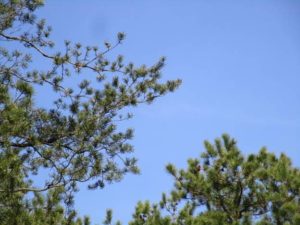
Virginia pine to the left, pitch pine to the right
After crossing Saw Mill Brook, I noticed a third pine in the old Szeliga’s Orchard: white, with supple needles in clusters of five. The species being easy to remember with its five needles, or W-H-I-T-E. It is not a native, here. This was probably an escape from nearby houses.
In the old orchard, I saw ground pine, or Lycopodium. Also, there was a nice little pond – I knew of the swamp, here, but did not remember this much ponding. And there was a fallen tree trunk, pecked by a woodpecker or woodpeckers.
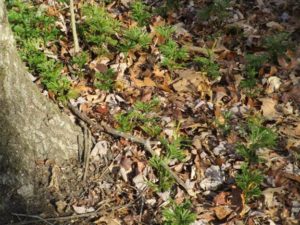
Ground pine at Szeliga’s Orchard
I got to the former worker homes of the George W. Helme Snuff Mill — which ceased production in 1993 and, this year, opened as apartments — and cut through the alley dividing them. After a visit to the Post Office and lunch at the store, I walked to Helmetta Pond.
There, I found a thin layer of ice along the shore – the temperature was now in the low 40s, but overnight it had got down to about 30. Canada geese sat in the pond on its other side by the woods. There, it was a mix of pines on the high ground, swamp hardwoods and Atlantic white cedar in the wetlands – and, it seemed, more and more invasive Phragmites reed grass.
On the way back, I took photos of ice in a ditch and Shekiro’s Pond, which had a cluster of punks, or cat-tails, dying off in the cold weather. Shekiro’s was fending off Phragmites nicely, unlike the Pond to the north and Cranberry Bog to the south.
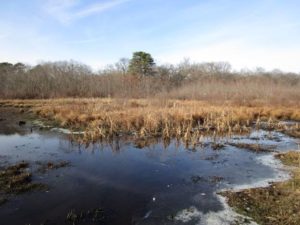
Shekiro’s Pond
At the Bog, I spooked a great blue heron, which took off slowly in flight. But not slowly enough for me to get a photograph. I did stop nearby, though, to shoot a stand of birch on the old Shekiro homestead.
On my way home, I was treated to a ConRail locomotive pulling two hopper cars toward Jamesburg. I snapped photos of the train, glad I had the camera with me over these few hours.
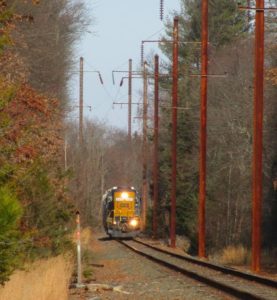
A ConRail train in Helmetta, heading toward Jamesburg
Joe Sapia, 60-years-old, grew up and lives in the Pine Barrens around Helmetta, where his family has resided for more than 100 years. He can be reached at Snufftin@aol.com or at P.O. Box 275, Helmetta, 08828.
Copyright 2016 by Joseph Sapia
by Joseph Sapia
Gardening: In Helmetta, Monroe, and Jamesburg
2016, August 7, Sunday, to August 13, Saturday
The gardening and yard references are to my house in the section of Monroe between Helmetta and Jamesburg in South Middlesex County. My yard is in a Pine Barrens outlier on the Inner Coastal Plain, the soil is loamy, and my neighborhood is on the boundary of Gardening Zones 6b and 7a.
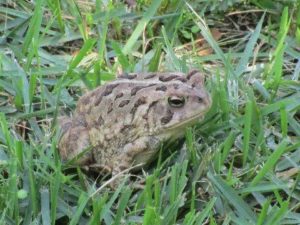
Fowler’s Toad
HARVESTING: Cucumbers. Picked a cantaloupe, but I should have waited. So, holding off on picking more cantaloupes.
TO HARVEST OR NOT TO HARVEST: My tomatoes are not moving – they are not growing and ripening, plants are dying. I think the wildlife has been getting to them….
THE LAWN: Because of work and the weather not cooperating on my days off (that is, either raining or threatening thunder storms with lightning), I got way behind on cutting the grass. So,…
CUTTING THE GRASS IN THE HEAT: I jumped on a sunny, day-off opportunity to cut the lawn – in 95 degrees with a heat index of 114 degrees. I wet my straw hat, stayed hydrated by drinking plenty of water, and took breaks. It was a grind for this old (59) boy. Three wet T-shirts and one fear-of-lightning break later, I finished the backyard.
CUTTING DOWN THE GARDEN: I mowed over the area where the lettuce had been planted – and, now, considering planting a late crop of lettuce. I also mowed down for the most part the done-producing corn stalks.
WILDLIFE IN THE YARD: The raccoons continue to topple the bird-feeder if I do not get it in the garage early enough at night. And I came across a Fowler’s toad — easily identifiable by the several warts in the splotches –while cutting the lawn. And, yes, the toad urinated when I caught him. I let him go in one of the high-grass wildlife patches I keep in the yard. (Photo of the Fowler’s toad.)
ROSE THORN IN MY FOOT: Despite wearing sneakers, I got a rose thorn in the big-toe area of my right foot. Pulled that sucker out fully. Not like the thorn or whatever that I have/had stuck in the ball of my left foot for about three weeks. Just keeping an eye on it, making sure it is not infected, waiting for it to work itself out.
MOSQUITOES: NJ has had at least three cases of West Nile virus in humans – one in Camden County, according to the state; two in Monmouth County (Atlantic Highlands and the Spring Lake area), according to the county. I checked a barrel I keep with a combination of rain, gray water, and de-humidifier water and found mosquito larvae in it. So, I emptied some of it and put a top on the barrel of the remainder. Interestingly, I cannot recall one mosquito bite this season.
— Joseph Sapia
2016, August 13, Saturday,
Joe Sapia, 59, has lived his whole life in Monroe. He is, among other things, a Pine Barrens naturalist and a vegetable gardener. He gardens the same backyard plot as did his Italian-American father, Joe Sr., and his Polish maternal grandmother, Annie Poznanski Onda. Both are inspirations for his vegetable gardening. And he draws inspiration on the local Pine Barrens from his mother, Sophie Onda Sapia, who lived her whole life in the local Pines, and his grandmother.
Photos and Writing by Joseph Sapia
The gardening and yard references are to my house in the section of Monroe between Helmetta and Jamesburg in South Middlesex County. My yard is in a Pine Barrens outlier on the Inner Coastal Plain, the soil is loamy, on the boundary of Gardening Zones 6b and 7a.
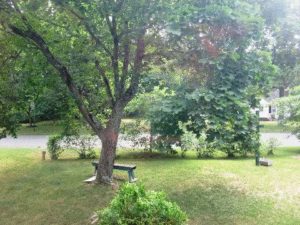
Front yard
EARLY MORNING HOURS IN THE GARDEN: On Wednesday, I got up around 5:20 a.m. for an early day at work and had the garden half-watered by 6 a.m. I watched the sky change color, listened to a crow, and watched a great blue heron fly by. Peace!
HARVESTING LETTUCE: I dug out 2 heads of lettuce and brought them to work for distribution. Worried the lettuce would start bolting in the heat wave, I was looking to use it up. It turns out there was no need to worry. The lettuce is still producing well, despite the heat.
LAST YEAR’S SUNFLOWERS: I had forgot I have last year’s sunflower crop hanging from the ceiling and drying in the garage. Well, I remembered and began spreading the seeds for the birds, squirrels, and any other wildlife that eats them.
BEARS ON THE MOVE: Various roaming black bear reports have come in over the last week or so: in South Brunswick and Milltown, for example. Stay clear and all should be OK.
FLOWERS IN THE VEGETABLE GARDEN: Cantaloupes, peas, and cucumbers are flowering, the sweet corn is in tassel, and a white flower is blooming. As for white flower, I am unsure if it is growing on its own, part of the pollinator seeds I threw down, or something else.
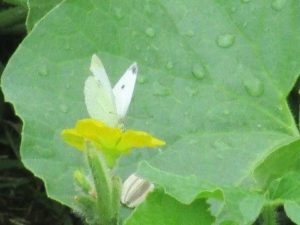
Cabbage White on Cantaloupe
“KNOCK OUT” ROSES: The “Knock Outs” seem to be doing something different this year — peaking, but retaining blooms, rather than losing all blooms until the next peak.

Knock Out Rose
AROUND THE YARD: Stinkhorn mushrooms are popping up.
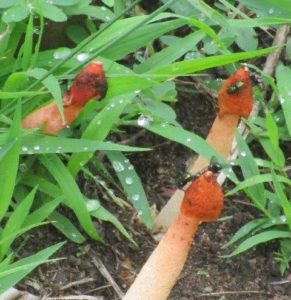
Flies on Stinkhorn Mushrooms
YARDWORK: Saturday’s thunderstorm forecast kept me from my planned trimming of the shrubs and hoeing the vegetable garden. The shrubs can wait, but I really need to attack the garden weeds on Sunday.
QUOTE OF THE WEEK: Friend Jimmy Krygier, a 3rd generation nurseryman of the 100-year Krygier’s Nursery on Cranbury Road just outside Helmetta, noted the perkiness of the vegetation as we were driving a backroad after the recent rains and he said something to the effect of, “The vegetation is smiling because of the rain. Even the weeds.”
DOWN THE SHORE: The clinging jellyfish, “Gonionemus vertens,” an invasive species indigenous to the Asian Pacific Ocean, has been found in the Shrewsbury River and Manasquan River recently. Their stings are very hurtful and could require hospitalization. They are not expected in Raritan Bay or in the Atlantic Ocean.
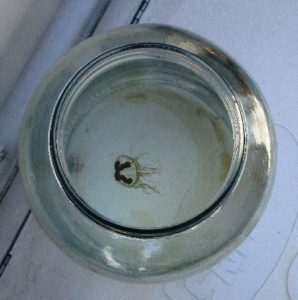
Clinging jellyfish from the Shrewsbury River at Monmouth Beach
SOMETHING TO WATCH FOR: In the local Pine Barrens, watch for the beginning of the “fall” foliage colors from around July 15 to July 30.
Joe Sapia, 59, has lived his whole life in Monroe. He is, among other things, a Pine Barrens naturalist and a vegetable gardener. He gardens the same backyard plot as did his Italian-American father, Joe Sr., and his Polish maternal grandmother, Annie Poznanski Onda. Both are inspirations for his vegetable gardening. And he draws inspiration on the local Pine Barrens from his mother, Sophie Onda Sapia, who lived her whole life in the local Pines, and his grandmother.
Photos and Writing by Joseph Sapia
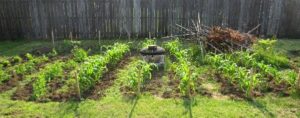
GARDEN AND AFIELD
2016, June 19, Sunday, to 2016, June 25, Saturday
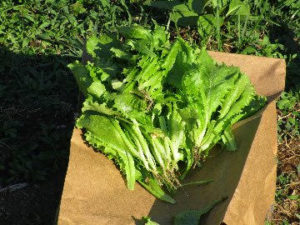
Lettuce
HARVESTING FROM THE GARDEN: I began picking lettuce, harvesting it leaf by leaf, rather than by the head, so the plant keeps producing. (In my haste, I pulled out too much leaf. So, next time, will clip them, saving the plant.) Then, I either munch on the leaf right there in the garden or take it inside for a sandwich.
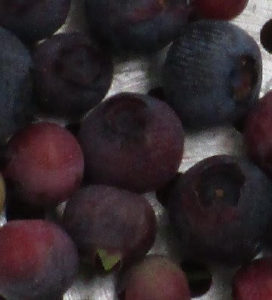
Wild blueberries
HARVESTING FROM THE LOCAL PINE BARRENS: Blueberries are ripening. I picked some the other day and mixed them into a cup of yogurt.
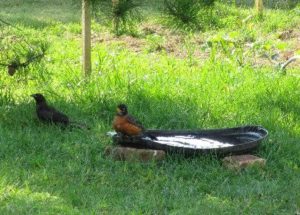
Bird bath
BIRD BATH: I keep a bird bath filled with water at ground level. Birds not only “bathe” in it, but birds and other animals drink from it.
WILDLIFE IN THE YARD: The raccoons are still taking advantage of the sunflower kernels in the bird-feeder. And, one evening, I saw a huge skunk passing by.
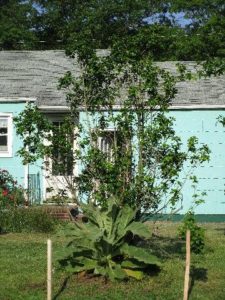
Mullein in front of the American holly
WEEDS IN MY YARD: As I have mentioned, I leave many weeds growing to see what they develop into. Well, I have a huge mullein taking over my American holly in my backyard. In the front yard, I have pokeweed growing.
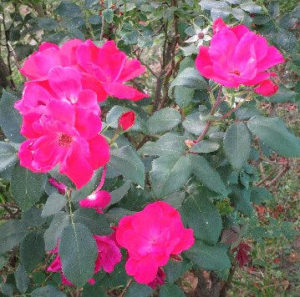
“Knock Out” roses
“KNOCK OUT” ROSES: Surprisingly, the first bloom of “Knock Out” roses continues.

Fungi in the backyard
FUNGUS, IN YARD AND WOODS: Fungi growing in my backyard and some in the local Pine Barrens.
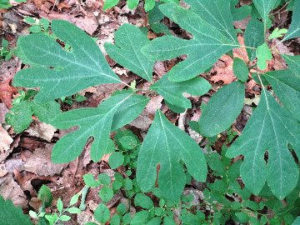
Sassafras with its three styles of leaves
SASSAFRAS IN THE LOCAL PINE BARRENS: Sassafras trees can have three leaf patterns on the same tree: a two-prong mitt, three-prong, and oval. I found an aberration this week, one with five prongs.
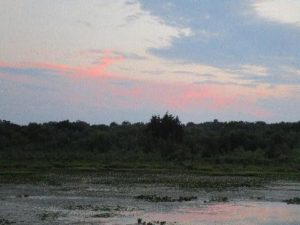
Helmetta Pond at sunset
Joe Sapia has been a professional journalist since the 1970s. He also is a writing teacher, folk artist, vegetable gardener, Pine Barrens woodsman, Helmetta area historian, and Jeep driver, along with being Marquette University Jesuit-educated..
Born in 1956, Joe is a lifelong resident of Central Jersey, where his family — through his maternal side, the old Polish and Slovak workers of the George W. Helme Snuff Mill in Helmetta — has lived since about 1900. He is a voice of the land and Old Jersey ways.
Photos and article by Joseph Sapia
Afield observations made in the Pine Barrens around Helmetta in South Middlesex County. Garden observations made in my yard, just outside of Helmetta.
THE GARDEN. Planted vegetables, cantaloupe, and flowers, all from seed, May 21. Sweet corn, cucumbers, and sunflowers are sprouting well. The tomatoes are just peeking through the soil.
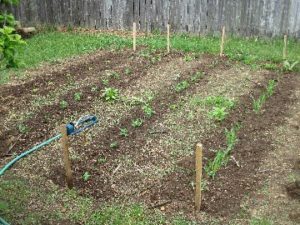
GARDENING CHORES. Planted black-eyed Susan seeds, finished lawn-mowing, weeded the garden, been watering the garden.
WATERING THE GARDEN. I use no fertilizer and no chemicals — to me, things ruining the local Pine Barrens ecosystem and time bombs in the soil and groundwater. But I water, a soaking preferably before 10 a.m., so less loss of water to evaporation in the sun’s heat and allowing the vegetation to dry so as not to pick up fungal growth. If I miss the pre-10 a.m. watering, I will try to water with a sprinkling can, low to the ground, underneath the vegetation.
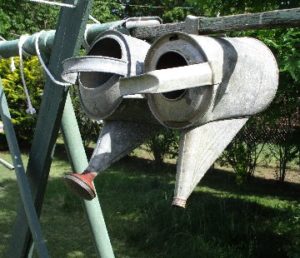
WATER CONSERVATION. Since taking over the family house in 2002, I have cut my water consumption in half for the most part. Some can be attributed to a needed bathroom remodeling (and a water-efficient toilet), but a lot is from simple conservation — do not run as much water, along with re-using gray water and rain water for watering plants. This week, for example, I watered the garden with a combination of house water and gray water, hoping to switch entirely to rain water and gray water.
MORE WATER CONSERVATION. Water from the cellar de-humidifier goes to the bird bath/watering trough. The trough, too, is recycled — a garbage can lid place on the ground, easy for birds to use, as well as squirrels and so on.
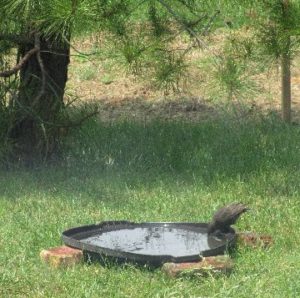
RACCOON AT THE BIRD-FEEDER. My friend continues to visit the bird-feeder, helping itself to the sunflower kernels. I let it do it for a good part of the night, then I put the feeder in the garage for the overnight.
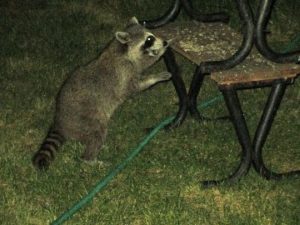
WILDLIFE AND ME. Un-rhythmic chirping crickets in my cellar in the middle of the night bring out the serial killer in me — wait till later this summer when that starts up!. But, generally, wildlife is very welcome in my yard (if not my house). This week, though, a raccoon, which I normally get within 7 or so feet of as I let it raid my bird-feeder, would not leave my garage after I startled it and it hid behind tools and so on. I poked around with a stick and finally gave up, left the doors open, and curled up on the love seat in the house until I heard rattling, meaning the raccoon was in the garbage can holding the bird seed. So, I got up, and shooed it away. Earlier, while weeding, I saw a rabbit — whose kind let me get within 5 feet or so — eating my sunflower sprouts. The hand-weeder in my hand flew across the garden. Get it? The rabbit surely understood.
WILD ON MY SIDE. Neat on the street side and neighbor side. I let my hedges and shrubs have a wild or English garden look facing inward. But I try to keep it neat on the public and neighbors’s sides. And I keep a number of wild patches in my side and back yards, making the best out of unproductive lawn ecosystems (photo 9) (I am puzzled by parents that worry about school bus stops, un-shoveled snowy sidewalks, and overcrowded classrooms, but do not worry about the chemicals on their lawns. Time bombs, I say, time bombs!)
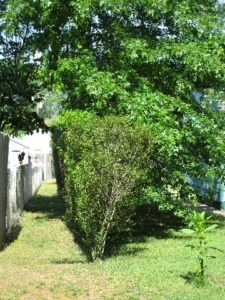
AROUND THE YARD. The season’s first bloom of Knock Out roses is wilting. Fungi (photos 11 and 12), mullein, and pokeweed sprout freely. I let this stuff grow, interested in how it looks.
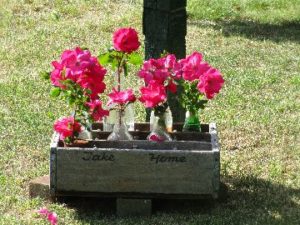
— WHAT IS GOING ON? In recent weeks, I have seen a brown thrasher (first I have seen in around 15 years), then I heard a whip-poor-will calling at my house (the first in an estimated 6 years), and, this year, the northern gray treefrogs have been hollering. Is nature coming back to the local Pine Barrens? Is the natural world becoming so condensed that nature is retreating internally? Does it mean anything?
— AND MOUNTAIN LAUREL IS BLOOMING Meaning turtles are out laying eggs, so be careful while driving. (And be careful: Do not pick them up by their tails and WATCH OUT FOR THE SNAP OF A SNAPPING TURTLE.) For the more fainthearted naturalists, the mountain laurel blooming is sort of an alarm clock that the woods will heat up, get muggy, and pine flies will be swarming.
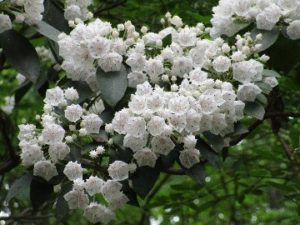
— MY INSIDE GARDEN. The view from my desk.
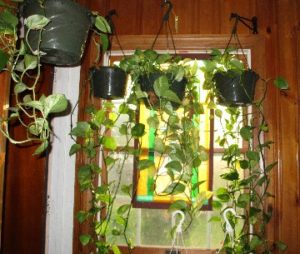
Copyright 2016 by Joseph Sapia
Joe is kicking off a new Facebook.com group, “The Jersey Midlands,” where this report is first published. To access The Jersey Midlands, go to the group and request access.
Joe Sapia, 59, is a vegetable gardener, who gardens the same backyard plot as did his Italian-American father, Joe Sr., and his Polish grandmother, Annie Poznanski Onda. Both are inspirations for his vegetable gardening. And he draws inspiration on the local Pine Barrens from his mother, Sophie Onda Sapia, who lived her whole life in the local Pines, and his grandmother.
Photos and text by Joseph Sapia
Garden and Afield in Helmetta-Monroe-Jamesburg, 2016, May 22, Sunday, to May 28, Saturday
From my yard in the Helmetta Road area of Monroe and the surrounding Pine Barrens
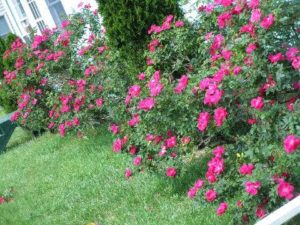
Knock-out roses
— “KNOCK OUT’ ROSES: The “Knock Out” roses are putting on a spectacular display, the best I recall since planting them in my yard in 2008.
— RACCOON/S AT THE BIRD-FEEDER: The battle continues between me and the raccoons at the bird-feeder. I have been putting the feeder in the garage at night, but the raccoon/s sometime beat me to the feeder.
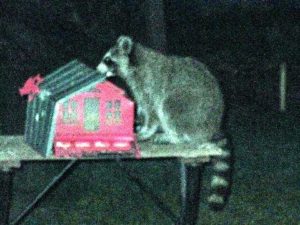
Raccoon at my backyard birdfeeder
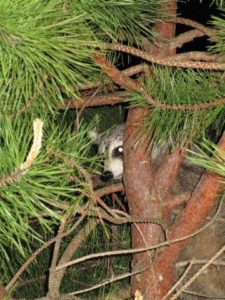
— CANADA GEESE GOSLINGS: Adult Canada geese are out and about with their goslings. The adults are amazing parents — and humans can learn from them, (Photo 6, at Helmetta Pond.)
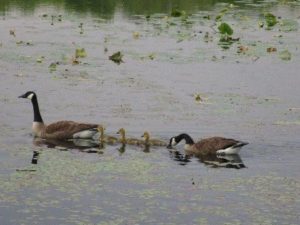
Canada Geese at Helmetta Pond
— NEW JERSEY STATE BIRD AT THE FEEDER: An Eastern goldfinch at one of my bird-feeders. Easily identified as a male because of the bright colors.
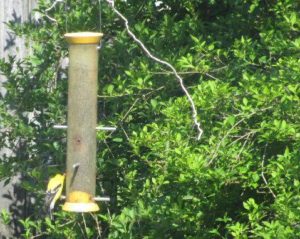
Eastern Goldfinch, the New Jersey state bird
— NORTHERN GRAY TREEFROGS: These called strongly during the week. See http://www.state.nj.us/dep/fgw/ensp/audio/no_gray_frog.wav.
— GARDEN: I planted May 21 and a week later plants were sprouting, most noticeable the Mammoth Gray-Stripe sunflower. Although I do not use fertilizer or pesticides, I water regularly. Once the plants get going, I water before 10 a.m. so as not to lose water to evaporation as the day warms.
— BLACK BEAR MOVEMENT: Reports continue about black bear sightings in Central Jersey and across the Delaware River in Pennsylvania. I am surprised there have not been more reports closer to home. If a bear is sighted, it is likely a 1-1/2-year-old male, perhaps 80 to 100 pounds, looking for its own turf. (What to do when encountering a bear, http://www.state.nj.us/dep/fgw/pdf/bear/bearfacts_know.pdf.)
— YARDWORK: I trimmed the shrubs, then started cutting the grass. I have to finish the lawncutting today. I still have to plant black-eyed Susans.
— BLAST FROM THE PAST, CIRCA LATE 1960S: Paul Migut with an 8-horsepower roto-tiller at his Uncle Stanley “Pon” Ceslowski’s garden on Old Road at Helmetta Road, Monroe. Over the years, Pon, Paul and Jim Becker worked that huge garden.

Paul Migut, circa late 1960s, at Pon’s garden
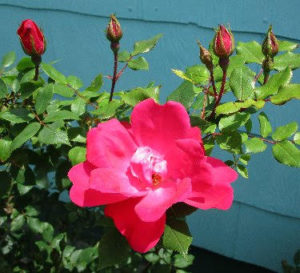
More knock-out roses
Joe Sapia, 59, is a vegetable gardener, who gardens the same backyard plot as did his Italian-American father, Joe Sr., and his Polish grandmother, Annie Poznanski Onda. Both are inspirations for his vegetable gardening. And he draws inspiration on the local Pine Barrens from his mother, Sophie Onda Sapia, who lived her whole life in the local Pines, and his grandmother.























































